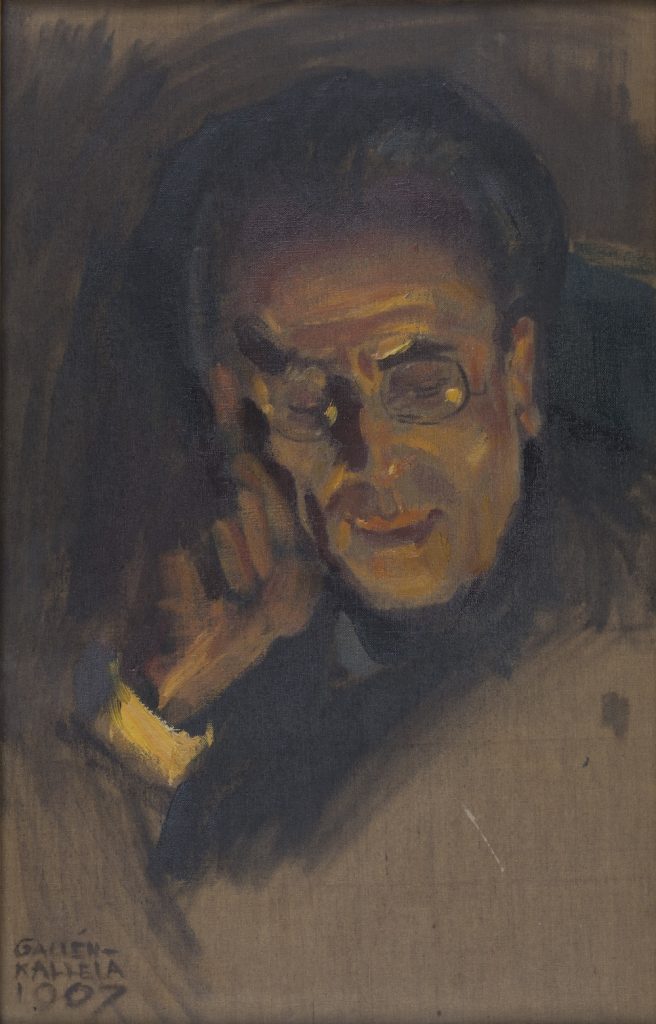The Portrait of Composer Gustav Mahler
“The artist took his canvas and began to paint me like Rembrandt with only the fire as his light,” said Gustav Mahler in his letter to his wife about Finnish artist Akseli Gallen-Kallela, then known as Axel Gallén. The world-famous Austrian composer did not agree to portraits during his lifetime. However, there is an exception to the rule in the collections of the Gösta Serlachius Fine Arts Foundation in Mänttä.
Gustav Mahler (1860–1911) visited Helsinki for work in 1907. Finnish composers, architects and artists entertained the maestro. In his first evening in Helsinki Mahler went to a popular concert conducted by Kajanus to get to know his orchestra. In the concert, Axel Gallen joined their table and promised to take Mahler on a water tour in Helsinki the very next day. Mahler was excited about this, because in his opinion it was the sea that gave Helsinki its superior essence. The next day the rain gave way to the sun. The entourage also included the famous architect Eliel Saarinen.
After the motorboat excursion, a horse carriage was waiting for the group, and they moved to the architects’ wilderness studio in Hvitträsk, which Mahler described as a castle. It was a national romantic studio home that Eliel Saarinen, Herman Gesellius and Armas Lindgren built for themselves in 1903 on shore of Lake Vitträsk in Kirkkonummi.
Herman Gesellius welcomed them, and they settled down to spend the evening. Mahler was confused about the love life of the architects because Eliel Saarinen and Herman Gesellius had joked about switching wives, but Mahler had taken it seriously. In fact, Eliel Saarinen’s ex-wife Mathilda had married Herman Gesellius, and Saarinen had married Herman’s sister Loja. Mahler was convinced that it was done with good intentions to refresh life.
Gallen-Kallela took his canvas and began to paint pensive Mahler. The sketchy work was created in half an hour while the composer was sitting by the fireplace. The model even got bored in the middle of it all and went for a walk, while Gallen-Kallela finished the piece. When Mahler was leaving Hvitträsk, Gallen-Kallela brought the painting on display. Mahler was impressed. He saw a Rembrandt effect in the dark sketch, where the warm colours on his face reflected the fire glowing in the fireplace.
The portrait of composer Gustav Mahler (1907) is a manifestation of the warm relationship between Gallen-Kallela and Mahler. They were old acquaintances. The gentlemen clearly admired each other and had already met once at the secessionist exhibition in Vienna in 1904, where Gallen-Kallela had many of his works on display. That evening, Mahler even lent his seat at the symphony orchestra concert to the Finnish artist.
Admiration is reflected in Mahler’s words to his wife when describing the artist: “He stood at the bow of the boat like a Viking; so straight and full of vitality. I wouldn’t be surprised if women fell at his feet again and again.”
The gentlemen’s good relations, Axel’s rascally cheerfulness and hospitality are probably the reasons why the maestro did not mind the fast-paced work of the young artist.
Bibliography
La Grange, Henry-Louis de. Gustav Mahler: Volume 3, Vienna: Triumph and Disillusion (1904-1907). Oxford: Oxford University Press, 1999. pp. 750–759.
La Grange, Henry-Louis de. Weiss, Günther., Martner, Knud (eds.) & Beaumont, Antony (trans.). Gustav Mahler: Letters to His Wife. Ithaca: Cornell University Press, 2004. pp. 288–294.
Homepage of the National Museum of Finland, Hvitträsk. Retrieved on 30 November 2022 from: https://www.kansallimuseo.fi/fi/hvittraesk/museo


